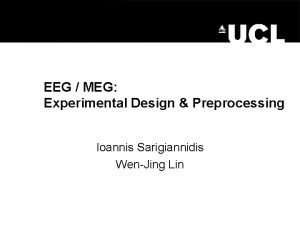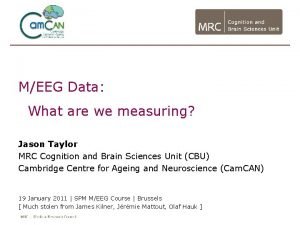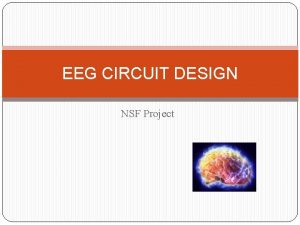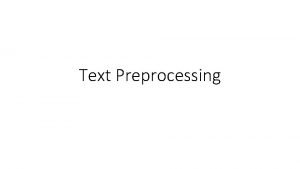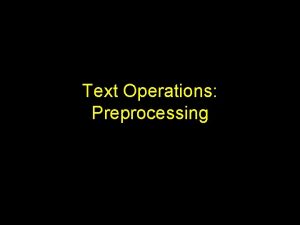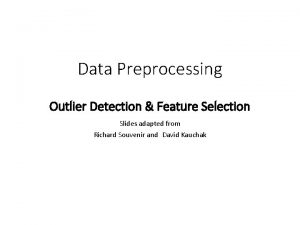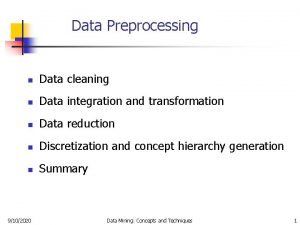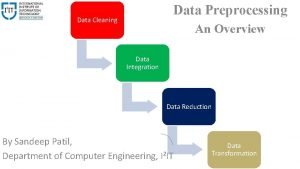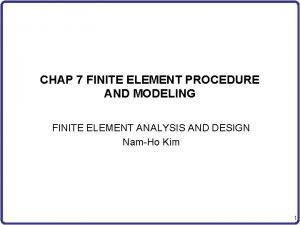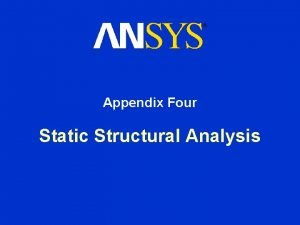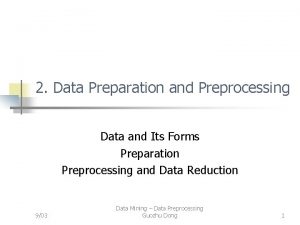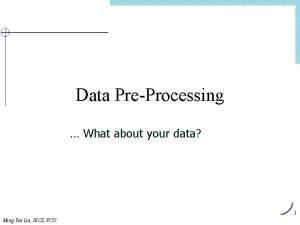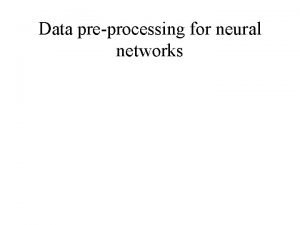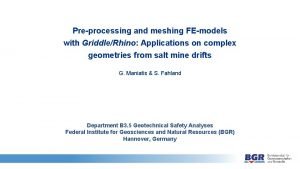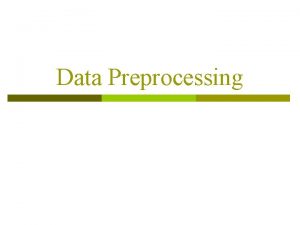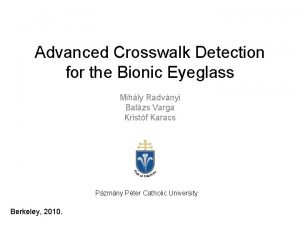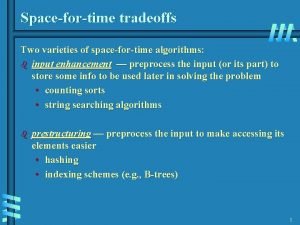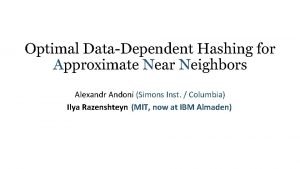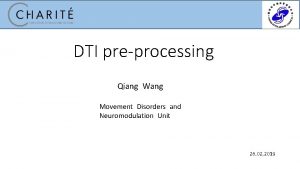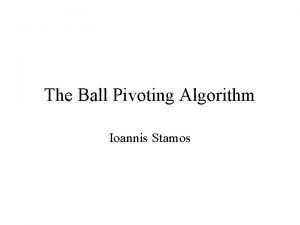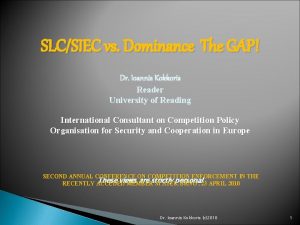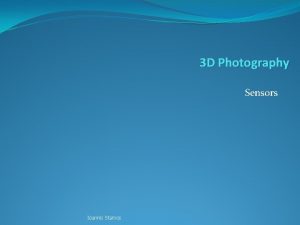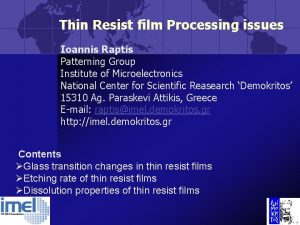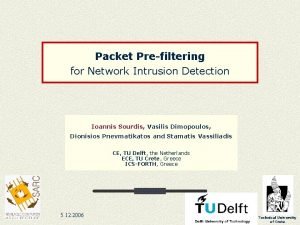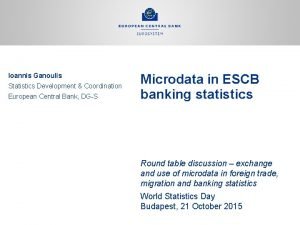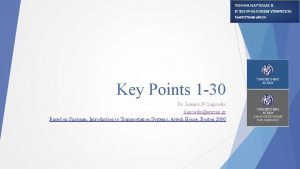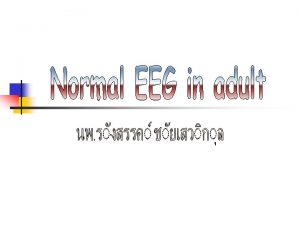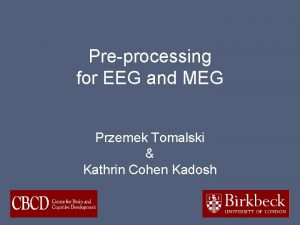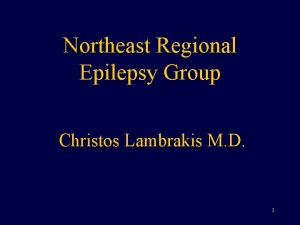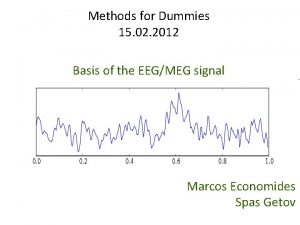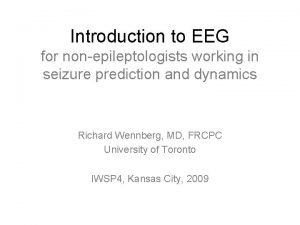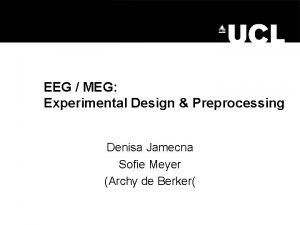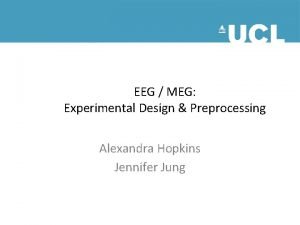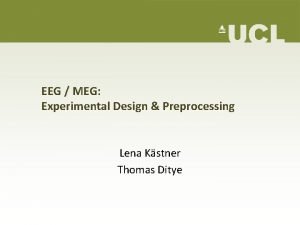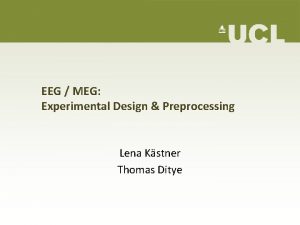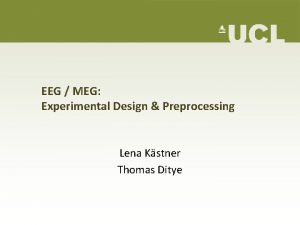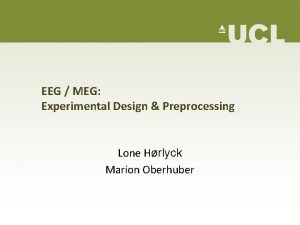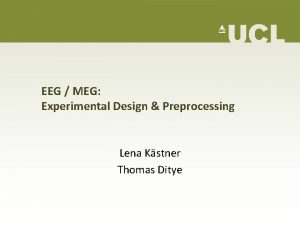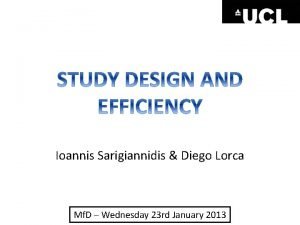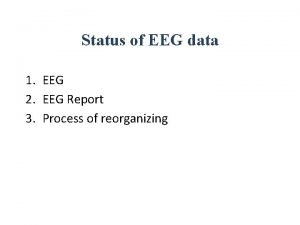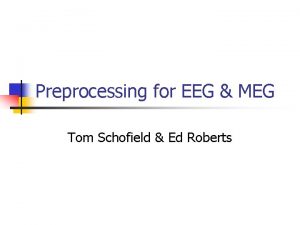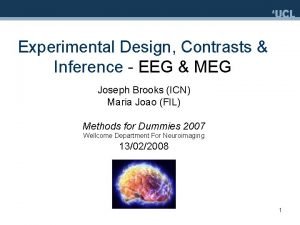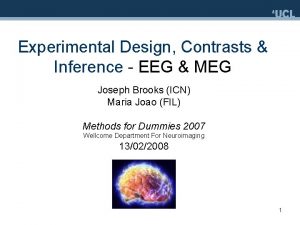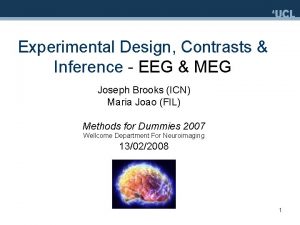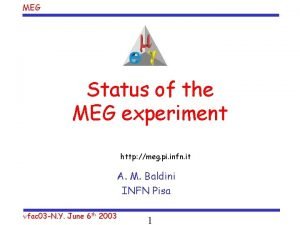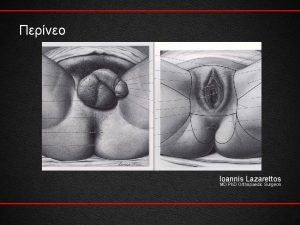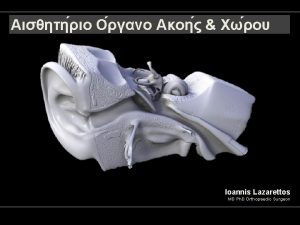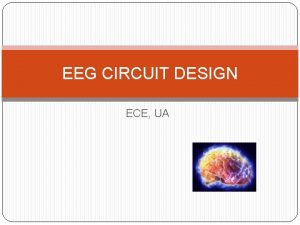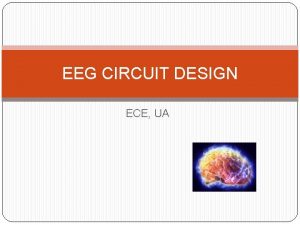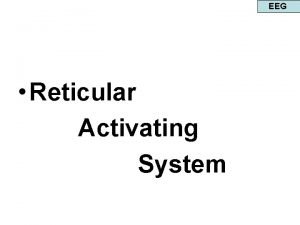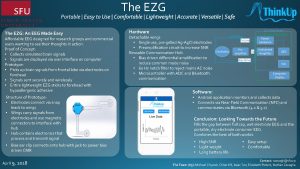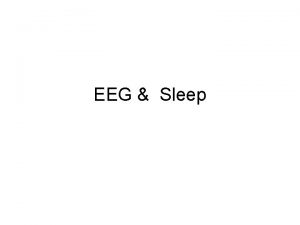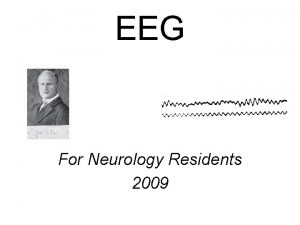EEG MEG Experimental Design Preprocessing Ioannis Sarigiannidis WenJing







































- Slides: 39

EEG / MEG: Experimental Design & Preprocessing Ioannis Sarigiannidis Wen-Jing Lin

Outline Experimental Design Preprocessing in SPM 8 • f. MRI M/EEG • Analysis • • – Oscillatory activity – EP • • Design Inferences Limitations Combined Measures Data Conversion Montage Mapping Epoching Downsampling Filtering Artefact Removal Referencing

f. MRI vs. MEG (EEG)

MEG vs. EEG Signal from pyramidal neurons of the cortex

MEG is mostly sensitive to tangential fields gyrus sulcus

Two types of MEG/EEG analysis Event related changes (EP / ERP – ERF) Oscillatory activity – cortical rhythms (Time-frequency analysis) Otten, L. (2012, November 21). EEG/MEG Acquisition, Analysis and Interpretation, MSc Cognitive Neuroscience, UCL

Oscillations Otten, L. (2012, November 21). EEG/MEG Acquisition, Analysis and Interpretation, MSc Cognitive Neuroscience, UCL

Evoked vs. Induced (Hermann et al. 2004)

Oscillations • Delta (0 – 4 Hz) • Large-scale cortical integration • Attentional and syntactic language processes • Deep sleep • Theta (4 – 8 Hz) • • Codes locations in space, navigation Declarative memory processes Successful memory encoding Episodic memory processing

Oscillations • Alpha (8 – 12 or 13 Hz) • Closed eyes • Level of cortical activation • Cortical and behavioral deactivation or inhibition • Perceptual, memory and attentional processes • Beta (12 – 30 Hz) • Alert, REM sleep • Attention, and higher cognitive function • Stop movement

Oscillations • Gamma (30 – 80 Hz) • Visual awareness • Binding of information • Encoding, retention and retrieval of information independent of sensory modality • Recording gamma activity in the human EEG is difficult • very small amplitude • similarity in terms of its frequency characteristics with electrical muscle activity • microsaccades – confused with gamma

Oscillations • Non-averaged data collected during continuous stimulation or task performance (or during rest) lends itself to analysis of spectral power. – i. e. We can do Fourier analysis and look at spectra (notevent related – break data in arbitrary segments and do some averaging) – e. g. sleep studies, mental states (e. g. meditation)

EP vs. ERP / ERF • Evoked potential (EP) – short latencies (< 100 ms) – small amplitudes (< 1μV) – sensory processes • Event related potential / field – longer latencies (100 – 600 ms), – higher amplitudes (10 – 100μV) – higher cognitive processes but used interchangeably in general

ERP/ ERF Stimulus/ Event Onset Average potential/ field at the scalp relative to some specific event Baseline: typically 100 ms before the onset of the stimulus

ERP/ ERF Averaging Non-time locked activity(noise) lost via averaging

Experimental design • Number of trials – EP: 120 trials, 15 -20% will be excluded – Oscillatory activity: 40 -50 trials • Duration of stimuli / task – Short: Averaged EP is fine – (Very) long: spectrotemporal analysis on averaged EP or non-averaged data • Collecting Behavioral Responses – Only if necessary!

Inferences Not Based On Prior Knowledge Observe Infer • Time course • Timing • Amplitude • Degree of engagement • Distribution across scalp • Functional equivalence of underlying cognitive process • Differences in ERP

Inferences Based On Prior Knowledge An “ERP component is scalp-recorded electrical activity that is generated in a given neuroanatomical module when a specific computational operation is performed. ” (Luck 2004, p. 22)

Observed vs. Latent Components Observed waveform Latent components OR

Design Strategies • Focus on specific, large and easily isolated component – E. g. , P 3, N 400, LRP, N 2 pc… • Use well-studied experimental manipulations • Isolate components with different waves • Component-independent experimental designs

Design Strategies • Avoid confounds and misinterpretations – Physical stimulus confounds • Side effect – What you manipulated indirectly influences other things • Vary conditions within rather than between blocks • Be cautious of behavioral confounds

Sources of Noise in EEG • EEG activity not elicited by stimuli – e. g. alpha waves • Trial-by-trial variations • Articfactual bioelectric activity – eye blinks, eye movement, muscle activity, skin potentials • Environmental electrical activity – e. g. from monitors

Signal-to-Noise Ratio • Size of the noise in average = (1/√N) ×R • Number of trials: – Large component: 30– 60 per condition – Medium component: 150– 200 per condition – Small component: 400– 800 per condition – Double with children or psychiatric patients

Limitations • Ambiguous relation between observed ERP and latent components • Signal distorted en route to scalp – arguably worse in EEG than MEG (head as “spherical conductor”) • MEG: application restrictions – patients with implants • Poor localization (cf. “inverse problem”)

Combining Techniques-How? • Converging evidence – Combination of different information from different experiments • Generative models – Establish generative models for which parameters are estimated from data of different nature.

Combining Techniques - Why? f. MRI & M/EEG • BOLD activity can occur without M/EEG. – Specific spatial configurations of the cells or of the sources may annihilate signals at the surface of the scalp. • M/EEG activity can occur in the absence of BOLD – synchronization may not necessarily consume enough energy to be seen in BOLD. • The two activities are not necessarily spatially congruent. Many studies have found discrepancies between EEG dipolar localization and f. MRI • M/EEG increased resolution improved localization

Technical M/EEG Considerations • Amplifier and filter settings • Sampling frequency • EEG – Number, type, location of electrodes – Reference electrodes • MEG – equipment and participant compatible with MEG? – [digitize 3 D head] matched to [structural MRI]

Outline Experimental Design Preprocessing in SPM 8 • f. MRI M/EEG • Analysis • • – Oscillatory activity – EP • • Design Inferences Limitations Combined Measures Data Conversion Montage Mapping Epoching Downsampling Filtering Artefact Removal Referencing

PREPROCESSING • Raw data to averaged ERP (EEG) or ERF (MEG) using SPM 8

Conversion of data • Convert data from its native machine-dependent format to MATLAB based SPM format *. bdf *. bin *. eeg *. mat (data) *. dat (other info) • Do not define setting: “Just read” • Define settings: • Read data as continuous or as trials • Select channels • Define file name

Downsampling • Sampling frequency: number of samples per second taken from a continuous signal • Data are usually acquired with a very high sampling rate • SF should be greater than twice the maximum frequency of the signal of interest? • Downsampling reduces the file size and speeds up the subsequent processing steps (e. g. 200 Hz)

Montage and Referencing • Identify v. EOG and h. EOG channels, remove several channels that don’t carry EEG data • Specify reference for remaining channels • Single electrode reference: free from neural activity of interest • Average reference: Output of all amplifiers are summed and averaged and the averaged signal is used as a common reference for each channel

Epoching • • • Cut out chunks of continuous data (= single trials) Specify time window associated with triggers [prestimulus time, poststimulus time] Baseline-correction: automatic; the mean of the prestimulus time is subtracted from the whole trial Segment length: at least 100 ms for baseline-correction; the longer the more artefacts Padding: adds time points before and after each trial to avoid ‘edge effects’ when filtering For multisubject/batch epoching in future

Filtering • EEG data consist of signal and noise • Some noise is sufficiently different in frequency content from the signal. It can be suppressed by attenuating different frequencies. • Non-neural physiological activity (skin/sweat potentials); (drifts – high pass filter takes care of that) noise from electrical outlets (bandstop) • SPM 8: Butterworth filter • High-, low-, band- pass or bandstop filter • Any filter distorts at least some part of the signal

Artefact Removal • Eye movements • Eye blinks • Muscle activity • Skin potentials • ‘Boredom’ (alpha waves) • Head movements

Artefact Removal • Hand-picked • Automatic SPM functions: • Thresholding (e. g. 200 μV) • 1 st – bad channels, 2 nd – bad trials • No change to data, just tagged • Robust averaging: estimates weights (0 -1) indicating how artefactual a trial is

References • • • Ashburner, J. et al. (2010). SPM 8 Manual. http: //www. fil. ion. ucl. ac. uk/spm/ Hansen, C. P. , Kringelbach M. L. , Salmelin, R. (2010) MEG: An Introduction to Methods. Oxford University Press, Hermann, C. et al. (2004). Cognitive functions of gammaband activity: memory match and utilization. Trends in Cognitive Science, 8(8), 347 -355. Herrmann, C. S. , Grigutsch, M. , & Busch, N. A. (2005). EEG oscillations and wavelet analysis. In T. C. Handy (Ed. ), Event-related potentials: A methods handbook (pp. 229259). Cambridge, MA: MIT Press. Luck, S. J. (2005). Ten simple rules for designing ERP experiments. In T. C. Handy (Ed. ), Event-related potentials: a methods handbook. Cambridge, MA: MIT Press. Luck, S. J. (2010). Powerpoint Slides from ERP Boot Camp Lectures. http: //erpinfo. org/Members/ldtien/bootcamp-lecture-pptx Otten, L. (2012, November 21). EEG/MEG Acquisition, Analysis and Interpretation, MSc Cognitive Neuroscience, UCL Otten, L. J. & Rugg, M. D. (2005). Interpreting event-related brain potentials. In T. C. Handy (Ed. ), Event-related potentials: a methods handbook. Cambridge, MA: MIT Press. . Sauseng, P. , & Klimesch, W. (2008). What does phase information of oscillatory brain activity tell us about cognitive processes? [Review]. Neuroscience and Biobehavioral Reviews, 32(5), 1001 -1013. doi: 10. 1016/j. neubiorev. 2008. 03. 014 Mf. D slides from previous years

Special thanks to our expert Vladimir Litvak

Kilner, unpublished Wager et al. Neuroimage, 2005
 Ioannis sarigiannidis
Ioannis sarigiannidis Eeg meg
Eeg meg Wenjing hu
Wenjing hu Wenjing lou
Wenjing lou Experimental vs non experimental
Experimental vs non experimental Experimental vs non experimental
Experimental vs non experimental Descriptive studies
Descriptive studies Experimental vs non experimental research
Experimental vs non experimental research Experimental vs non experimental
Experimental vs non experimental Eeg circuit
Eeg circuit Text preprocessing steps
Text preprocessing steps Document preprocessing
Document preprocessing Outlier
Outlier Etl in data cleaning and preprocessing stands for
Etl in data cleaning and preprocessing stands for Entity identification problem in data integration
Entity identification problem in data integration Image preprocessing
Image preprocessing Image preprocessing
Image preprocessing Data preparation and preprocessing
Data preparation and preprocessing Categorical aggregation
Categorical aggregation Neural network data preprocessing
Neural network data preprocessing Preprocessing fem
Preprocessing fem Major tasks in data preprocessing
Major tasks in data preprocessing Preprocessing in image processing
Preprocessing in image processing Password hashing and preprocessing
Password hashing and preprocessing Password hashing and preprocessing
Password hashing and preprocessing Applytopup
Applytopup Ioannis kakadiaris
Ioannis kakadiaris Ioannis demertzis
Ioannis demertzis Ball-pivoting algorithm
Ball-pivoting algorithm Ioannis kokkoris
Ioannis kokkoris Ioannis stamos
Ioannis stamos Ioannis raptis
Ioannis raptis Ioannis sourdis
Ioannis sourdis Banks integrated reporting dictionary
Banks integrated reporting dictionary Ioannis lagoudis
Ioannis lagoudis K complex eeg
K complex eeg Eeg sweat artifact
Eeg sweat artifact Ne regional epilepsy group
Ne regional epilepsy group Eeg for dummies
Eeg for dummies Seizure
Seizure
